Refinement Meetings | What they are and how they help
Refinement meetings can save your team time by ensuring all of your tasks are well thought out beforehand. But what goes into a good refinement meeting, and how useful are they really?

Though there are many different kinds of meetings, the meetings where you aim to get aligned with your team about the status of a certain goal are some of the most common, and can be the most lengthy overall. But why is this?
Think back to a recent project management meeting you had with your entire team. How organized was the meeting? Did everyone contribute? Was everyone efficient about discussing their progress, or was the meeting derailed at any point with members getting caught up in the details for any given topic? Did the meeting run on time, or was it longer than expected?
It’s easy to lose track of time in a planning meeting where everyone has the opportunity to contribute their thoughts to current problems the team is facing. While this can be incredibly useful as new and valuable ideas might be suggested, does everyone on the team really need to be there to strategize about every step toward your common goal?
The pitfalls of getting too detailed in your meetings
Let’s take a look at a more concrete example of how you might want to run an efficient project management meeting. Ideally, such a meeting would run by everyone providing a short presentation on their progress, noting what has been completed, what is left to complete, and what issues have been encountered. All of these points should be kept high-level, so that other teammates and stakeholders who didn’t directly work on these tasks still have a coarse (but accurate!) idea about what is going on, allowing the team to be directed appropriately.
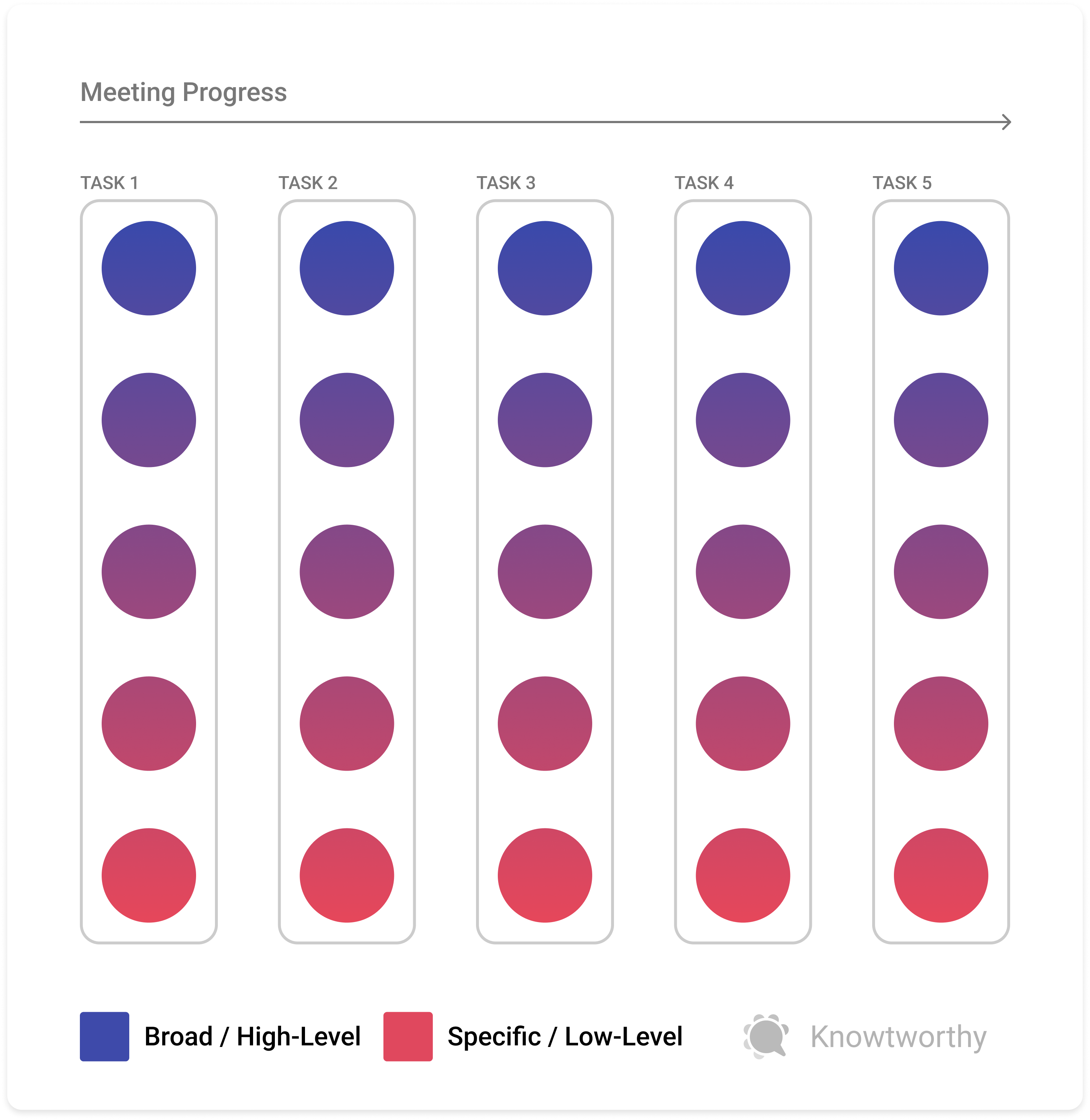
Let’s take a look at a visual representation of how project management meetings might be structured. In the image above, each column represents one particular task, or portion of a project. High-level points are outlined at the top, while in-depth points are at the bottom. An example of a high-level point in a software development context might be something like “Creating a check-out flow” for an e-commerce page. The lower down you go in the column, the more specific the tasks or points become. In the same example, the lowest level task might be to “automatically populate coupon codes to a user’s cart.
So while you can pass vertically from one level of depth to another, you’ll see that if for every agenda item that needs to be covered at your meeting, you go through every single level of depth for every single point, the meeting would need to cover way more content than one that just passes from one point to the next at a high level.
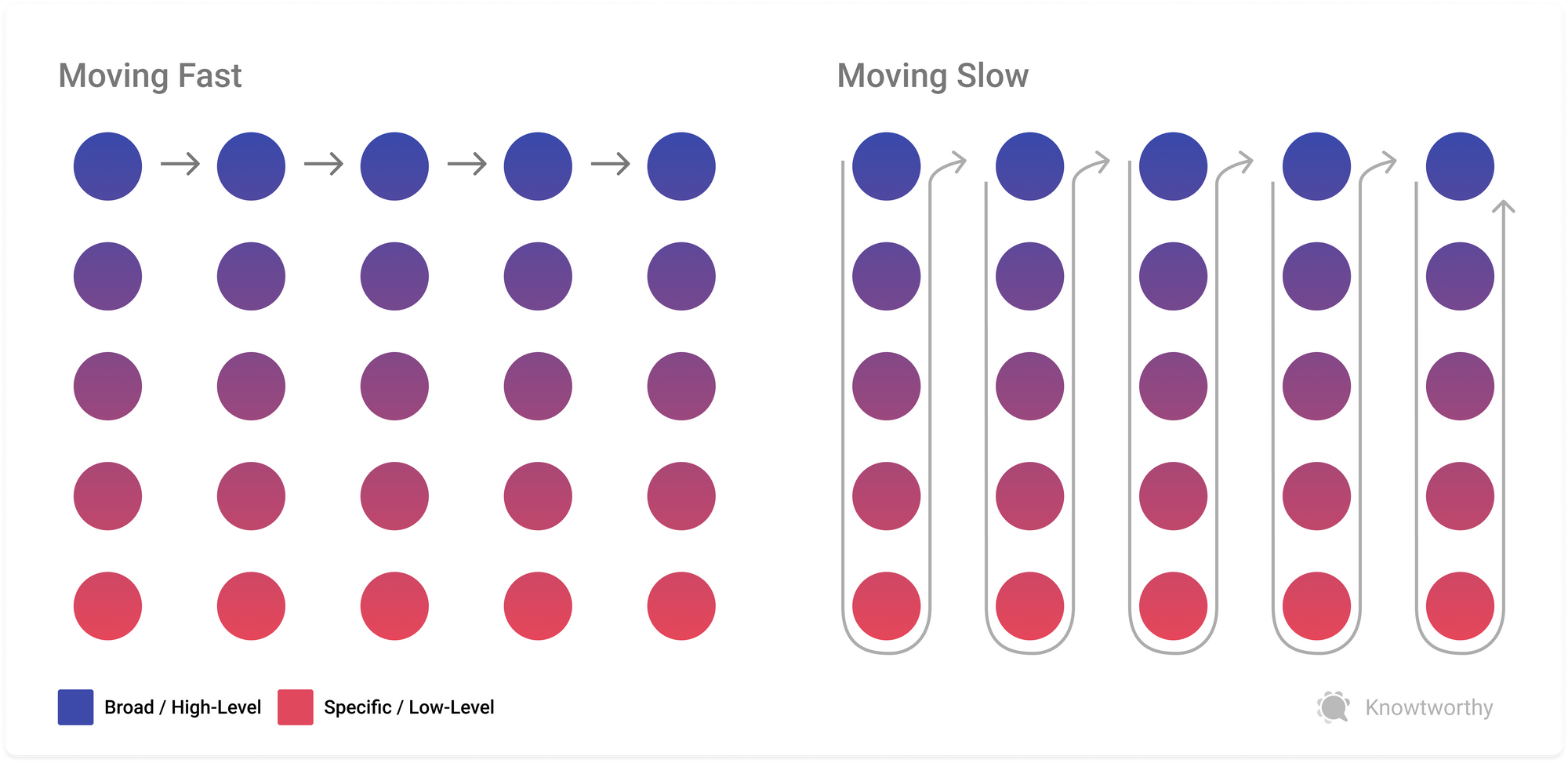
In some cases it might not be detrimental to go deep on every topic as passing through every level of depth would keep everyone on your team maximally informed. But in the majority of cases, does everyone actually need to understand all of this minutiae? Does someone like the product manager really need to know about a developer’s struggle with populating coupon codes during every meeting? Hopefully not!
With the goal of efficient meetings in mind, let’s look into a different strategy for refining discussion items in your meetings to help your project management meetings run more effectively so that you can spend time only on what is critical and glean the most from your team’s combined knowledge.
What are refinement meetings?
Refinement meetings are generally undertaken by Agile teams using the SCRUM methodology, and though there is a definition provided for what refinement is and what they are for, you don’t need to adhere to a SCRUM or Agile methodology to make the most of this process. Let’s take a look at the definition first and then see how we can generalize it.
Refinement is the act of breaking down and further defining Product Backlog items into smaller more precise items. This is an ongoing activity to add details, such as a description, order, and size. Attributes often vary with the domain of work. SOURCE
Refinement meetings also fit into an Agile sprint cycle by happening before new task planning, in a loop like the one you see below.
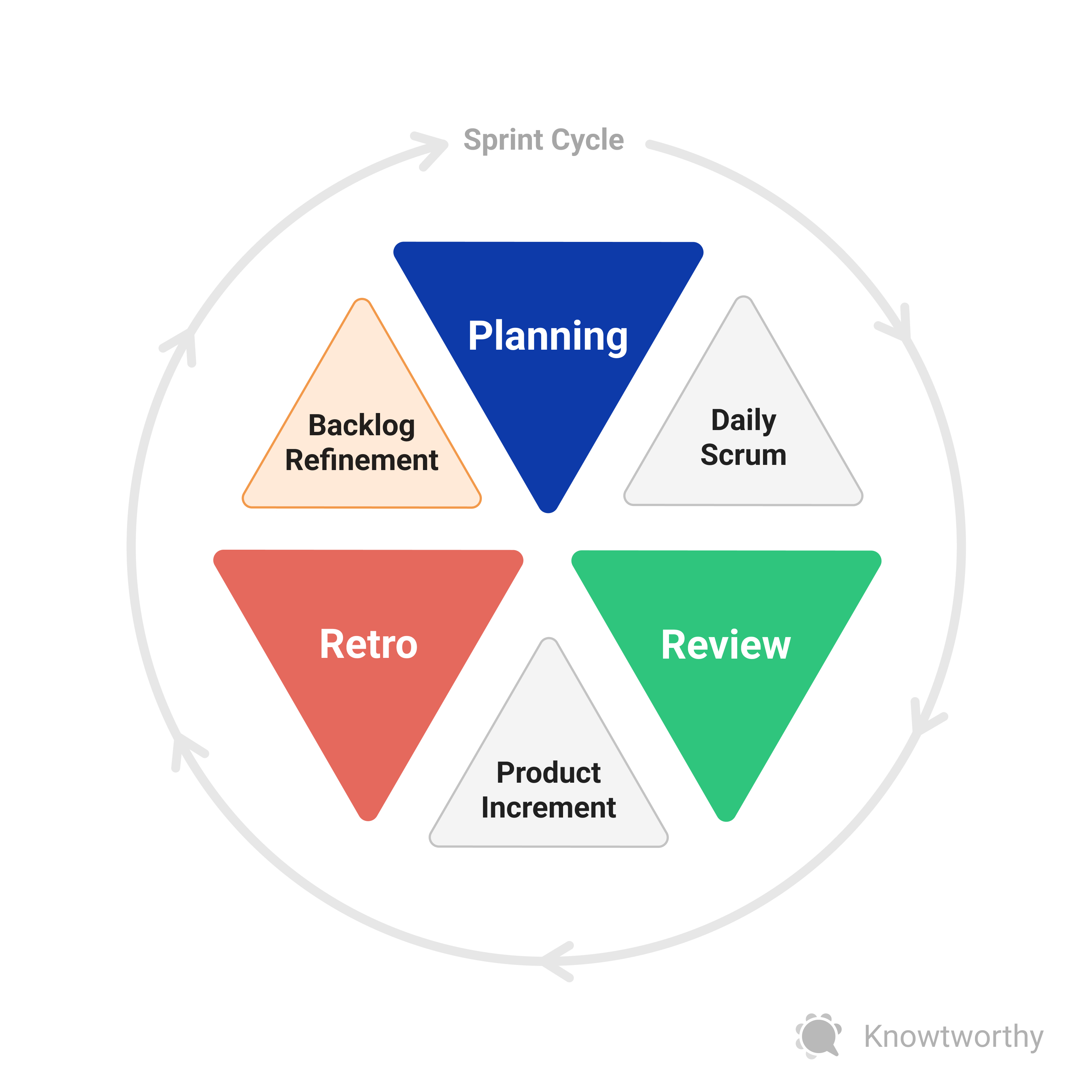
Logically, it is important to make sure tasks are properly defined before you can estimate how long they might take to complete and assign them to team members. Similarly, problems encountered should be digested by a team before they are presented to the group.
How refinements save you time
While a refinement meeting may seem like yet another meeting that you have to add to your already busy schedule, if done correctly, it can save your team time as a whole, because only a subset of the group needs to attend.
Referring back to our e-commerce example above, you don’t need the entire team to diagnose why one developer is having trouble with adding coupons to the check-out flow. Instead, it makes more sense to set up a meeting between that developer and one or two colleagues to come up with some potential solutions before the next sync or project management meeting with the whole team. Note that the project manager does not need to attend every single one of these meetings either! The refinements should be kept as atomic as possible to make sure that the team as a whole is using time optimally.
This way, the conversation during the project management meeting can stick to the high-level points of each task so that even when the issues surrounding a particular task are mentioned, the context wouldn’t be to ask for help or opinions on fixes. Instead, the problem encountered can be mentioned in the context of the solutions already hashed out.
Depending on the size of your team or the scope of a certain task, you may encounter questions where it does actually make sense to ask the entire team a certain question to hear everyone’s opinion. In this case, it doesn’t make sense to schedule an entirely separate meeting. Though make sure you truly do have a question for everyone before posing it, lest you default back to examining progress at every level of specificity as we cautioned against in the images above.
Now that you have some idea of the value of atomic refinements, let’s move on to what it takes to actually run high-quality refinement meetings.
Running a refinement meeting
There are other guides that look at how SCRUM-compliant refinement meetings should be run, but in the remainder of this article, we’ll review some more relaxed guidelines that will help you make the most of everyone’s time without needing to stick to a strict set of rules.
Which tasks need refining?
The first question you might have is: which tasks — of the myriad that need to be completed — actually need refinement? It’s true that if you spend time trying to revise every single task that your team needs to complete, you’ll end up spending more time in meetings than actually working!
So, a good way to determine if a task needs refining is to ask yourself the following questions:
- Are the steps to completing this task clear?
- Is this task manageable for a single team member?
- Is this task routine or have very similar tasks been completed before?
If you answered “Yes” to all three of the questions above, then great! This task likely doesn’t need refinement. The main idea being that so long as a task is clear, team members won’t need to delve into a discussion during the planning meeting. Furthermore, if a single person can complete the task (even if it needs to be a specific team member) you can overlook some of the clarity required for the other questions since the entire team does not necessarily need to be apprised of every minor task detail.
However, if you answered “No” to any of the three, it is likely a good idea to schedule a refinement meeting to ensure you have a well-thought-out task before assigning it to one or more team members. We’ll take a look at what that would involve below.
When to schedule a refinement meeting and how long should they be?
While some articles label refinement meetings as recurring meetings with many members, a more general approach shouldn’t have a set time for refinements at all. In fact, setting a recurring refinement meeting of fixed length should be avoided if at all possible!
Since the purpose of this type of meeting is to shore up any points of confusion about certain tasks, not only should a refinement meeting be scheduled exclusively when there are tasks that require further investigation, but the length of the meeting itself should be determined by how many tasks there are to go over. Though every case is different, we recommend that you time-box every discussion item beforehand and schedule accordingly.
For example, we try to allocate 15 minutes per item for refinement when necessary, and on weeks where only two items need to be discussed, we’ll meet for 30 minutes in total. If you find that you have dozens of items to cover during a particularly long planning week, we recommend that you split these up so that your individual meetings are no longer than 90 minutes - though some would argue that keeping things to 45 minutes or less is preferred.
Once you know how long your meeting is going to be and what items will be discussed, let’s look at who should be invited to these meetings to ensure that you are using your team’s time as efficiently as possible.
Who should be invited?
The answer to this question is rather intuitive, but make sure you are always asking yourself the following prompt before sending out the refinement meeting invite:
Who on the team knows the most about this item and could complete it the quickest?
Sometimes the answer to this question could just be one person, or sometimes a small group of people are needed to complete a certain task. Your goal is to narrow down the number of people needed to attend a given refinement meeting while ensuring that those who are invited can provide the full picture on every item you hope to cover.
It also helps to group your refinements by topic to ensure that your attendees can all speak about every item. For example, you don’t want to choose items for refinement that require completely different skill sets and have to invite several teammates to have access to their breadth of knowledge. You’ll find that your team is more engaged when everyone can contribute to every item. Thus, if you can group refinement items by topic, you’ll be rewarded with a more detailed outcome from every meeting.
If you do find yourself needing to refine unrelated items, try splitting the meetings up and inviting just the people that need to be there. No one will be annoyed that they only need to be present at a meeting for 15 minutes instead of 45, and the more time you save your team, the happier everyone will be!
How do you know when you’re done refining?
It can be tricky to know when a task is well-defined enough that everyone in a project management meeting understands the goals with no remaining questions. It may be the case that even after refinement, questions that you don’t have answers to will come up during team meetings - and that’s okay! It is simply important to minimize the number of interruptions caused, and a great way to do that is to ensure you have invited the right people to the refinement in the first place. So long as the team experts who you have invited are confident that every part of a given task is clearly laid out, you should be all set.
Another great way to check if an item has been refined enough is to ask someone who isn’t a domain expert to check on the item and see if they have any questions about the sub-tasks outlined or the methodology employed. If someone who isn’t intimately acquainted with the steps needed to complete a task can clearly see what needs to be done and the complexity of the task, you’ll know that you’ve done a good job!
An example to get you started
In the final section of this article, we’ll take a look at an example task and take you through the following steps:
- The initial state of the task when it is created
- What a refinement meeting would look like for this task
- How this task is transformed after refinement and before it is assigned.
Up until this point we’ve looked at the kinds of tasks that need to be refined, how and when to schedule refinement meetings, who to invite, and how to determine when a task is ready for presentation to the team. But now let’s look at what processing an example task could actually look like. Keep in mind that these aren’t hard and fast rules that must be followed, but instead a set of guidelines that you can keep in the back of your mind while running great refinement meetings.
New Task: Add “Use Case” Pages to the Company Website
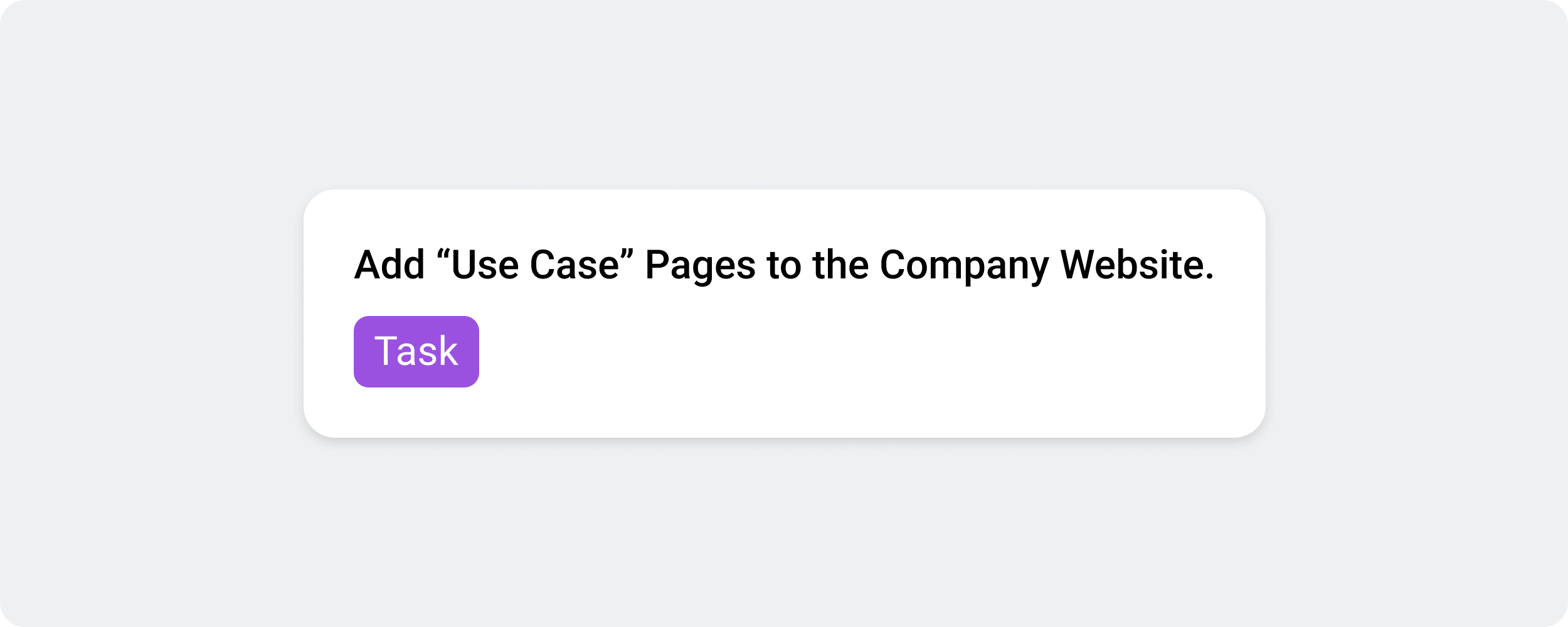
At a first glance, this task looks pretty self-explanatory. The goal here is to grow the discoverability of your company’s website and improve the experience of users trying to learn more about how your product or service might help them. But how exactly do we go about executing this task? How long will it take? Who should be responsible and what are the steps to completion?
You could try and figure out the answers to each of these questions at your next team meeting, but do you really need everyone present to iron out the related sub-tasks? From here, consider the unknowns listed above and any others you might think of, and determine who on your team would be able to help the most, with coverage of every question.
Now it’s time to schedule the meeting! Since we are only looking at a single task here, schedule a 15-minute meeting with the relevant teammates and send out the invites. Bonus points for sending out an agenda beforehand! Even though it is only a single item, having your team be aware of the discussion point and purpose of the meeting will help them arrive prepared. If you really want to keep things simple, sending out a shared document where everyone can jot down some notes before arriving can make your meeting even more efficient.
Once everyone is at the meeting, let’s take a look at a good way to run things.
Running the Refinement Meeting
There are many guides out there that outline a set of steps to follow during your refinement meetings, but we advocate for a laxer set of rules, so long as you achieve the goal of adding all of the context you need to a particular task, with something called the DEEP method.
Though you can take a look at the DEEP method requirements in detail if you are interested, the most important point is that your task is Detailed Appropriately. That is, once the team member assigned to the task begins working on it, they should have everything they need to get started: all of the necessary context, the sub-tasks required, who to coordinate with on certain aspects of the task, and the reason that the task is being completed.
Going back to our example of “Use Case” pages, those in attendance at the refinement meeting should help you itemize the flow of the entire task. By the end of the meeting, you should have something like the completed card in the image below, where the purpose of the task is clear, the sub-tasks are evident, and the time necessary to complete the task is agreed upon. All told, you should aim for something like the task pictured below.
A fully refined task!
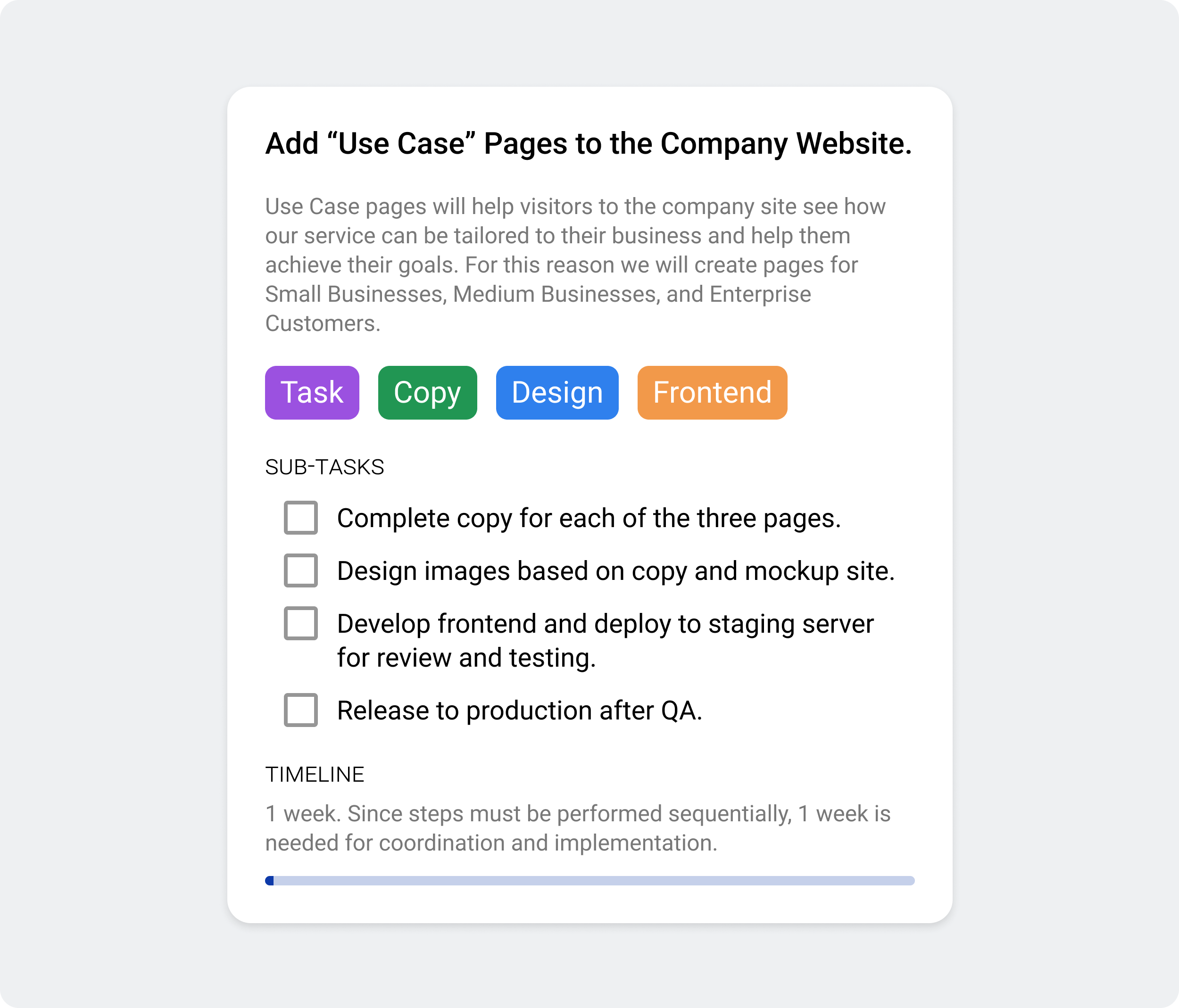
After the refinement meeting, your task should be fully described and ready for presentation during the next team planning meeting. With our example of the “Use Case” pages, you’d expect the task to look something like in the image above, but we’ve also added the full details below for your convenience.
TASK: Add Use Case Pages to Company Website
PURPOSE: Use Case pages will help visitors to the company site see how our service can be tailored to their business and help them achieve their goals. For this reason, we will create pages for Small Businesses, Medium Businesses, and Enterprise Customers.
SUB-TASKS:
- Complete copy for each of the three pages.
- Design images based on copy and mockup site.
- Develop frontend and deploy to staging server for review and testing.
- Release to production after QA.
TIMELINE: 1 week. Since steps must be performed sequentially, 1 week is needed for coordination and implementation.
While these details are important, you are always free to add more information if you think it will help your teammates grasp all of the information needed. For this reason, we also recommend that you take good meeting notes during your refinements about every item discussed so that if there are any outstanding questions, you can send out the notes to provide additional context, instead of interrupting the planning meeting.
Bringing it all together
Overall, we’ve seen that the purpose of refinement meetings isn’t simply to flesh out task details, but to do so in a way that saves your entire team time during planning meetings. If your refinements are executed correctly, planning meetings should no longer get derailed over minor detail discussions and can actually be used just for planning.
Sticking to a very strict set of rules for your refinement meetings can hinder creative thinking, so we advocate for a loose set of guidelines and goals to keep in mind when running yours. In general, try to keep the refinement of one task down to 15 minutes and only invite the team members that must be there. Make sure to keep good notes throughout these meetings and add as much context as you think is necessary to each task to ensure everyone involved in completing the task is clear on the requirements.
Simply by making these small adjustments to how your team already figures out task requirements, you should be able to save your entire team time every week, helping to boost their productivity and clarity on their work!
